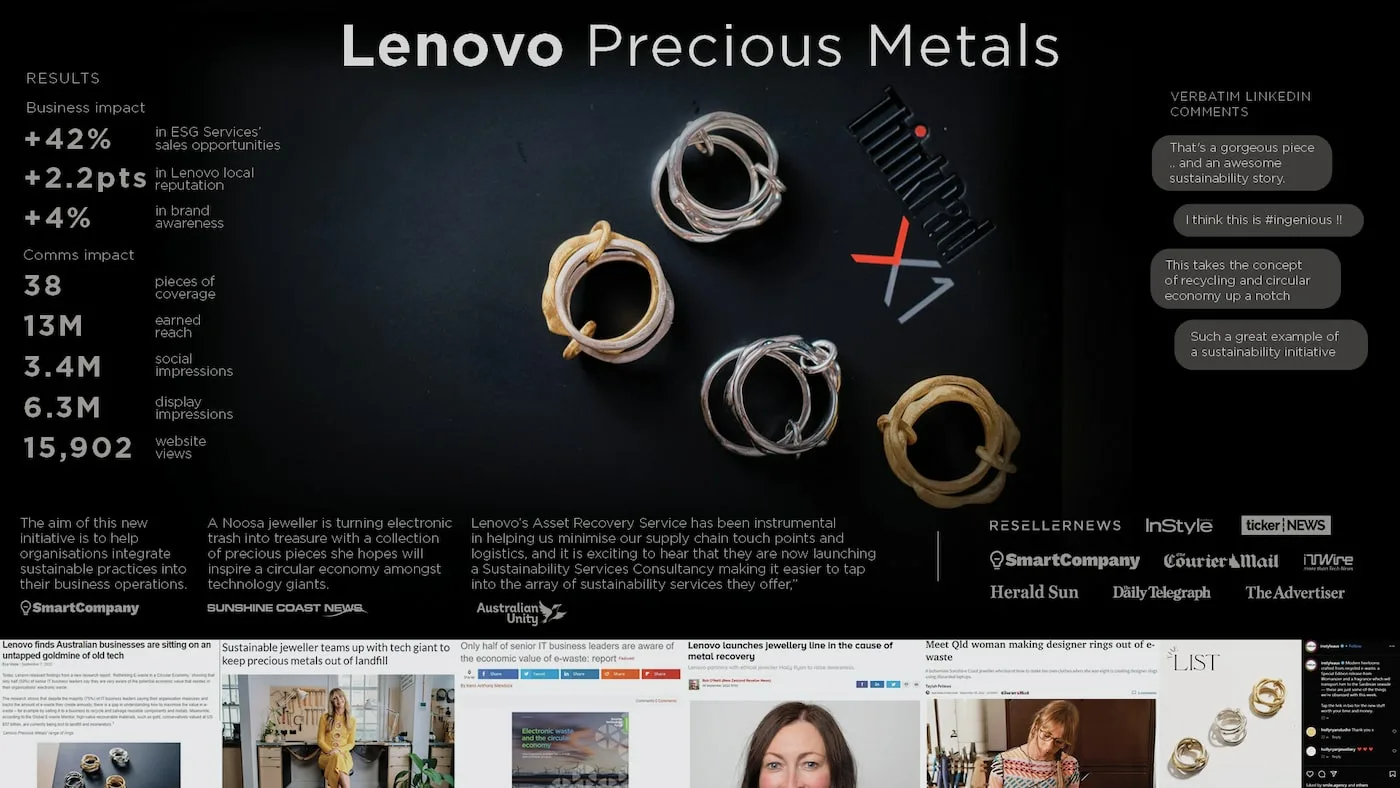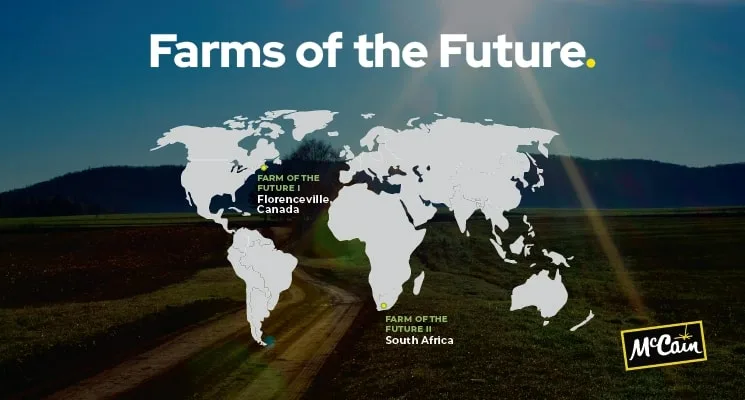While consumer choices collectively make a big difference, they can’t solve the climate crisis alone.
In fact, some studies even show the number of folks who say rescuing the environment is important to them dropped since 2020, partly due to apocalypse fatigue. The idea that individuals should carry all the responsibility for climate change is getting jarring.
Sustainable businesses (you?) can step up and help lift the heavy load towards large-scale change – with creative marketing campaigns to communicate impactful initiatives. It’s a fine way to lead by example.
This article explores four B2B (business to business) sustainability marketing campaigns that showcase corporations setting the standard for responsible corporate behaviour.
Future of regenerative agriculture
- Brand: McCain Foods
- Campaign: Farms of the Future
According to Potato News Today, the humble potato produces the least greenhouse gas emissions.
Still, McCain recognises the impacts of intensive agriculture of the world’s third most valuable food crop, causing water scarcity, soil degradation and biodiversity loss.
With potato farming at the heart of business, it makes good sense that McCain stepped up to address the future of the global food system.
To combat these concerns while feeding a growing population, the multinational manufacturer of frozen foods shows the way forward with its Farms of the Future initiative.
The strategy behind it all
This campaign is designed to reduce emissions and renew ecosystems. It’s where McCain works with farm partners to “reimagine the way we grow a potato that is better for both their farm and the planet.”
Max Koeune, CEO and President of McCain Foods says, “The farm of the future is meant to bring together the technology of the 21st century and nature-based solutions and the way to achieve that differs from country to country—and that’s what this is about… nature-based, locally based solutions.”
“What we are really keen to prove is that the farmer of the future and regenerative agriculture can have a great impact on the soil, on water management, on biodiversity and be economically sustainable,” Koeune explains.
The world’s largest frozen food company plans to run three Farms of the Future by 2025, dedicated to developing regenerative agricultural practices.
How it’s going
Two Farms of the Future are currently operating. The first season at Farm of the Future Africa and third season at Farm of the Future Canada are now complete.
As per McCain’s sustainability report, these already met the targets—with 21.9% of potatoes of water stress-tolerant varieties, McCain improved water-use efficiency by 9.4% in regions facing water stress and provided over 23,500 hours of training to farmers.
And in 2021, the Farm of the Future Canada reduced fertiliser application by almost 17% while sustaining yields.
This is significant information because fertilisers contain methane, carbon dioxide, nitrogen and ammonia, which produce emissions that contribute to the growing quantity of greenhouse gases in the atmosphere. Those same gases that cause global warming and climate change.
Koeune says “Partnership and knowledge are crucial to move forward.”
A climate-positive society
- Brand: Schneider Electric
- Campaign: Green Yodha
Through the Green Yodha campaign, Schneider Electric wants government bodies, institutions, businesses and civil society to adopt sustainability into all areas of life. But this is no average initiative. It’s an awareness campaign pursuing a climate-positive society.
The idea is to unite both corporate and individual sustainability goals through practices in energy efficiency, automation and digitalisation. As such, Schneider Electric aligns the Green Yodha Program with their comprehensive sustainability strategy, merging internal commitments with external partnerships.
With that, the campaign recognises the evolution of sustainability—from an early focus on environmental conservation to an approach that highlights the interconnectedness of nature, people and culture.
It’s about encouraging and supporting brands that want to invest in research and green manufacturing, reduce their carbon footprint and assist local communities.
Their 3-step approach helps businesses do just that.
In association with the 17 UN Sustainable Development Goals (SDGs), the company also carried out the Schneider Sustainability Impact (SSI) dashboard to regularly monitor its sustainability performance.
The strategy behind it
The campaign segmented B2B customers based on similar size, industry, location, product awareness, relative value, or other factors, and established awareness via varied digital and on-ground initiatives with businesses that operate in Consumer Products & Goods, Mobility and Water/Water Waste, Management, and Power & Grid.
One successful example is the thought leadership summit on climate change Schneider Electric hosted in 2023 in partnership with CNBC-TV18, which saw great attendance of prominent industry leaders like G Asok Kumar, Director General National Mission at Clean Ganga, Videh Jaipuriar, CEO at Delhi International Airport Limited (DIAL), Dr. Vibha Dhawan, Director General at TERI, Sriram Khattar, MD at DLF Rental Business, and Sunil Gupta (aka Data Center Man of India), Co-founder, MD and CEO at Yotta Data Services.
How it’s going
What makes this campaign special is that Schneider Electric conceptualised the cause as a mass movement to inspire folks from all necks of the woods to do their part. It’s a movement that ramps up the urgency to adopt climate-positive solutions faster through responsible marketing.
Anil Chaudhry, Zone President, India and CEO & MD Schneider Electric said, “I am extremely happy that this powerful initiative has already created strong momentum and reached over 10 million individuals and businesses.”
So far, 31% organisations are accelerating their sustainability efforts through automation and electrification.
Power of the circular economy
- Brand: Lenovo
- Campaign: Lenovo Precious Metals
E-waste has grown annually from 20 million to 50 million tonnes since 2000, making it the fastest-growing solid waste stream in the world.
These alarming numbers got Lenovo thinking. How can businesses minimise e-waste while relying on technology to thrive?
Secure lifecycle management. That’s how.
To raise awareness of its Asset Recovery Services (ARS), the tech giant saw an opportunity to engage B2B customers creatively and subsequently launched Lenovo Precious Metals.
The core of the campaign is to demonstrate that businesses are throwing away one of the most precious metals—gold. And then showcase how ARS can turn e-waste into exquisite treasures. Thereby, adopting a circular approach to “breathe new life into old technology.”
“Transitioning to a circular economy has never been more critical,” said Matt Codrington, MD of Lenovo. “We are committed to lessening our impact on our planet and to reduce, reuse, and recycle wherever possible. One area we’re focused on is e-waste management. Our study, ‘Rethinking E-waste in a circular economy’, looks to understand current e-waste practices and awareness of the value of e-waste in organisations,” he added.
Lenovo’s research from the YouGov survey also brought attention to the overlooked economic potential of e-waste due to low awareness and employee expectations.
This data then allowed them to delve into conversations about talent attraction and engagement.
The strategy behind it all?
In partnership with Australian sustainable jeweller, Holly Ryan, showcases four kinetic rings on a bespoke page.
Lenovo supplied Holly with sterling silver, platinum and gold recovered from old Lenovo hardware to create a range that is Wabi Sabi in aesthetic—a celebration of the imperfect beauty of nature and circularity.
Lenovo also tapped into various digital and on-the-ground marketing tactics to gain both B2B and B2C engagement, and reach environmental and workplace media.
From top-of-funnel marketing like blog posts, video, and organic and paid social media content to engagement at TechWorld ANZ through video, display and a jewellery-making workshop.
How it’s going
Overall, the campaign achieved a 42% increase in sales opportunities, a +2.2-point increase in local reputation, a 4% increase in brand awareness, 13 million reach through non-paid editorial coverage and offset 2.6 tonnes of carbon emissions.

With that, 69% of folks said they look at Lenovo “more favourably” because of the campaign.
Read the full case study on Shorty Awards.
It’s clear by these impacts Lenovo is positioning itself at the vanguard of e-waste management.
In essence, this campaign calls on other artists and creators to “explore the infinite potential of recovering precious metals and materials from Lenovo hardware.” And through its ARS program, Lenovo “helps businesses get the most out of their end-of-life hardware.”
Smart buildings for a better present and future
- Brand: Siemens Building Technologies
- Campaign: Creating Perfect Places
Did you know?
Buildings are responsible for nearly 40% of global CO2 emissions. Only 11% is from the materials and construction stage. The majority is purely operational. Every time you turn on a light, use the AC, or switch on the heating, there’s an environmental cost.
All in all, it can get pretty inefficient.
Which is why there’s a growing demand for smart buildings and infrastructure. Like all other smart tech, it’s about marrying data with a building’s existing systems and other data sources. Why? For more control, connectivity, efficiency, and cost savings. And let’s not forget the sustainability argument, of course.
To promote the company’s Smart Infrastructure, Siemens AG launched the #CreatingPerfectPlaces campaign.
The strategy behind it all
#CreatingPerfectPlaces is an online awareness campaign, created in collaboration with Theim Kommunikation. At its core, it shows what Siemens Smart Infrastructure really does: creates perfect places.
The focus shifts away from the technology behind the product. Because let’s face it, the technical details of how something works aren’t always so thrilling. Instead, they dive into the stories of the folks who use Siemens solutions to build the kind of place they want to work, learn, and live in.
It nails the art of effective storytelling for successful B2B communication. And it does that by leveraging the power of emotional connection to show viewers what makes a perfect place and how it’s created. With building technology from Siemens.
Throughout the campaign, the German multinational repeatedly featured the #CreatingPerfectPlaces hashtag in all sorts of social media content.
How’s it going
According to Theim, the campaign generated well over 14 million social media impressions and attracted 18,000 new followers.
The high relevance, emotional depth and quality of the #CreatingPerfectPlaces stories didn’t only convince Siemens’ employees and business partners. They’ve also won over the judges of international marketing and media prizes. Including, the prestigious Golden Dolphin at the Cannes Corporate Media & TV Awards.
To learn more about their Smart Infrastructure business, visit the microsite over here.
Deposit your thoughts below if these B2B sustainability marketing campaigns inspired you, or if you know of a campaign that deserves to be featured – or even if you’d like to be featured. Also, get in touch with us if you need to bridge the good you do and a great B2B marketing strategy. We’ll get back asap.




Leave a Reply